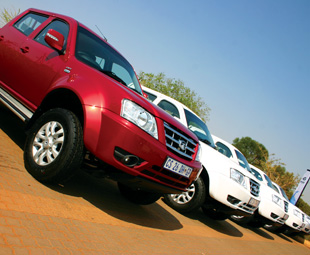XTending the appeal

Tata has launched the new Xenon XT with the aim of broadening its appeal among the bakkie-buying fraternity. GAVIN MYERS drove it at launch.
The Tata Xenon has been playing in the “work” section of the South African market for a number of years now – something it’s been fairly well suited to thanks to its rough, no frills demeanour. The company – keen to expand the range’s appeal into other areas of the market, such as the family, leisure, 4×4, construction and security industries – has now thoroughly re-evaluated the Xenon product offering.
Enter the Xenon XT, a vehicle Tata is confident will plug previous gaps in its product line-up and lead to a doubling of sales over the next two months …
So what’s new? Through a series of customer surveys, the company established that the Xenon was lagging in terms of peace of mind, safety, comfort and technology. Most of the upgrades are in line with these aspects.
Up front, the new generation 2,2-litre VTT DiCOR (Variable Turbine Technology, Direct injection Common Rail) engine, controlled by a Delphi 32-bit control unit, is tuned to meet Euro-5 emission standards. Unfortunately, due to South Africa’s current fuel quality, it has been detuned to meet local Euro-2 requirements. Nevertheless, it offers seven percent more power (110 kW at 4 000 r/min) and 21 percent more torque (320 Nm between 1 500 and 3 000 r/min) than its predecessor, while being 12 percent more fuel efficient.
Driving through a five-speed gearbox and electronically lockable rear differential (on double cab models; single cabs have a limited-slip diff) the engine pulls strongly and instantly throughout the rev range – thanks to the variable vein turbo. There really is close to zero turbo lag.
Other enhancements across the range include a three-layer body construction, driver and passenger airbags, collapsible steering column and remote central locking with transponder immobiliser.
Further broadening the Xenon XT’s appeal is the addition of a double-din Telefunken multi-media unit that includes navigation, Bluetooth and USB connectivity. However, although we certainly tried, my co-driver and I could not figure out how to operate the unit properly … Electric windows, power steering, front and rear fog lamps and electronically controlled air-conditioning are all standard.
Double cab models also get side steps and a lined load bin. The loading dimensions measure in at 1 430 (l) x 1 410 (w) x 400 mm (h) on double cab models. Single cab models have a load bin length of 1 880 mm. Quoted payload figures are up there with others in the segment, ranging from 975 to 1 225 kg. The gross vehicle mass ratings range from 3 000 to 3 100 kg.
Where Tata is really taking the fight to the opposition is in the “peace of mind” stakes. The new Xenon XT range is offered as standard with a four-year/120 000 km warranty, a four-year/120 000 km anti-corrosion warranty and a five-year/90 000 km service plan with four-year/unlimited mileage road-side assistance. Prices begin at R189 995 for the single cab 4×2 and go up to R269 995 for the double cab 4×4.
So, has Tata succeeded in taking the Xenon XT to new, previously untapped buyers? It is likely to do well as a vehicle aimed at municipal, farming, mining or construction fleets. However, the family and leisure buyers, and some in the 4×4 fraternity, will almost certainly look elsewhere. Unfortunately, the vehicle’s cabin is much smaller than those of its rivals, the driving position is overly compromised, ride comfort and body control could be improved somewhat and there were a few squeaks and rattles in the cabin of the brand new vehicle that we drove.
While the upgrades to the Xenon range were indeed deserved, time will tell if the Xenon XT does in fact broaden the market for Tata.
Published by
Focus on Transport
focusmagsa




